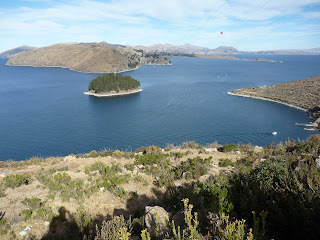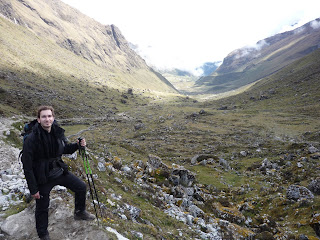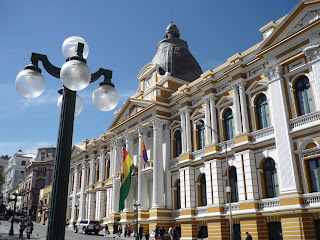After a long detour via Chile, several hours on a tortuous bus, an attempt of bribe by the Chilean police at the border and some more memorable landscapes (see pic attached), I finally made it to La Paz, the core destination of my travels and where I expect to spend at least a month. This will give me the chance to somehow settle for a while after constant packing, unpacking,repacking and daily bus journeys, and to be part of a volunteer project with children in need in the city.

I will have plenty of time to tell you about my experiences down here and to describe what I found as a really fascinating and massive city, full of contrasts and placed at a height that seems unreal (4000m on the higher part of the city known as El Alto). But today I will focus my attention on a dramatic experience lived two days ago while I went down the most dangerous road on earth, the sadly famous Death Road, and that has tought me a really important lesson I thought I wouldn´t get until my departure from South America, when all lived experiences become part of my memory. This dramatic event sadly rushed the process.
Let me first give you some background information about the Death Road. The Yungas Road, otherwise known as The Death Road, is a 65km downhill road that leads from La Paz to Coroico. The road used to be the only way of transportation between the Northern Amazon part of Bolivia and La Paz. The road is extremely narrow, completely unpaved, surrounded by the scariest dropoffs and weather conditions can make visibility really difficult. This is the reason why this road has claimed the life of hundreds of people since its construction in the 1930s during the Chaco Wars between Bolivia and Paraguay. The main core of traffic is diverted now to the new road, built in 2006, leaving the Death Road for the almost unique use of tourists looking for a thrill and few locals. I wanted to see this macabre road full of crosses on the sides and so I took part in one of the popular mountain bike tours that follow this road on a daily basis. I was told it is not that dangerous, as long as you are cautious and keep full concentration on the constant bumps and curves of this narrow road. But fate was keeping a tragic surprise for me.





What started as a thrilling mountain bike ride in a sunny day, enjoying the most impressive landscapes, turned to tragedy while biking one of the most dangerous parts of the road. As part of the tour, our minivan was following us and we would stop frequently for the driver to take some pictures of us in this stunning valley. It was when we stopped at the most famous turn (yes, the one you can see in all postcards and guides), that a scream caught our attention. The rest happened too quickly, but in a slow motion like feeling. I only remember a bike slipping off in the section of road opposite to where we were standing, and falling off, down the cliff, for approximately 50 meters before it even hit the ground. I am not too sure whether my mind has eradicated the image of the biker, but my biking mates remember clearly having seen her falling into the void. I only remember saying Oh my God, Oh my God, Oh my God, before realising someone was quite likely to have died in front of my eyes at that precise moment. I rushed to the guide of the tour to which the biker belonged to and screamed in Spanish that someone had fallen down the steep cliff.
There is not much we could do to save the life of the Japanese girl, whose friends stood staring at the valley in state of shock as expecting her to come back up again with a few bruises as if nothing serious had happened. We assisted as much as we could with the rescue, but our efforts were helpless and when the guide of our group came up again after having descended more than 100m down the cliff (apparently the girl had rolled down to a depth of 120m), the most shocking moment took place. He swore several times, while trying to catch his breath, before informing the rest of the group that their friend was dead. Despite it still looked unreal, it was then we realised this hadn´t been a joke. Someone had just become the 31st deadly biking victim of this road at the very exact moment we had stopped for some pictures. The biggest irony of it all was that the group had biked the road before and had decided to repeat it again as they had highly enjoyed it. That was a lesson of death.
It was difficult to hold down the tears and our whole group was still in a state of shock for a while. I cannot describe now all the things that passed through my mind: a sudden need to call my girlfriend, all my family and friends and tell them I was alive; an odd and sudden attachment to life, almost as a celebration; several questions why and failed attempts to understand how this had happened; a strange fear to those mountains, like a sign of respect. I was lucky to be alive, the thrill of doing this road had dropped and all I wanted to do was to finish the tour and be back in the hostel to assimilate the situation. It was psycologically draining and my mind was even more exhausted than my sore arms and fingers (this is due to the constant braking, as hardly any pedalling is needed in this downhill route).

Today, this whole things seem like a bad dream to me. I am awake and I am alive. I can only be happy for that and realise that this life is too short to be wasted. It needs to be enjoyed every minute and face the toughest situations in the best possible way. We need to appreciate what we have and disregard all the minor things to which sometimes we give too much importance. Behind this story, there is broken family and several mourning friends, but there is also someone who´s learnt an important lesson that will be used for the rest of my life.
I am back in La Paz, starting a sort of routine: mornings chilling at the hostel and afternoons working at a children´s home. I just started yesterday, but these two days working with 3-6 year old kids (either orphans or from troubled families) have already thought me another lesson. A good lesson of life. Their smiles make every effort put into this worth millions. The main activities are workshops where we play music, sing, dance, work on plastic arts or sports. Exhausting it is. But a pure joy. For these little kids, everything is wonderful and surprising. From the hair of my four day beard to my hiking boots or tattoos. They live inside the center and never go out, having school in the morning and workshops in the afternoon. Unfortunately, I cannot post any picture of the "little devils", due to strict regulations that forbid to take any pictures at the center to avoid any attempts of human traficking. Sad but true. This is reality in South America.
Should any of you decide to support this organisation, Para Los Niños, by making a donation or maybe volunteering if visiting Bolivia, please find below a link to their website. You will find there more about their activities and the kind of projects they are involved in.
http://www.boliviaparalosninos.org/
I will tell you more about Bolivia in following posts. In the meantime, I will leave you with some pics of my first week in the country.
Enjoy and keep posting comments! I promise to take some time to answer the comments posted so far. I would also like to remind you that I recently made the blog open for comments without a need for registration, so it will only take you two minutes to drop a line and cheer me up. I miss you guys.
Peace.
























































